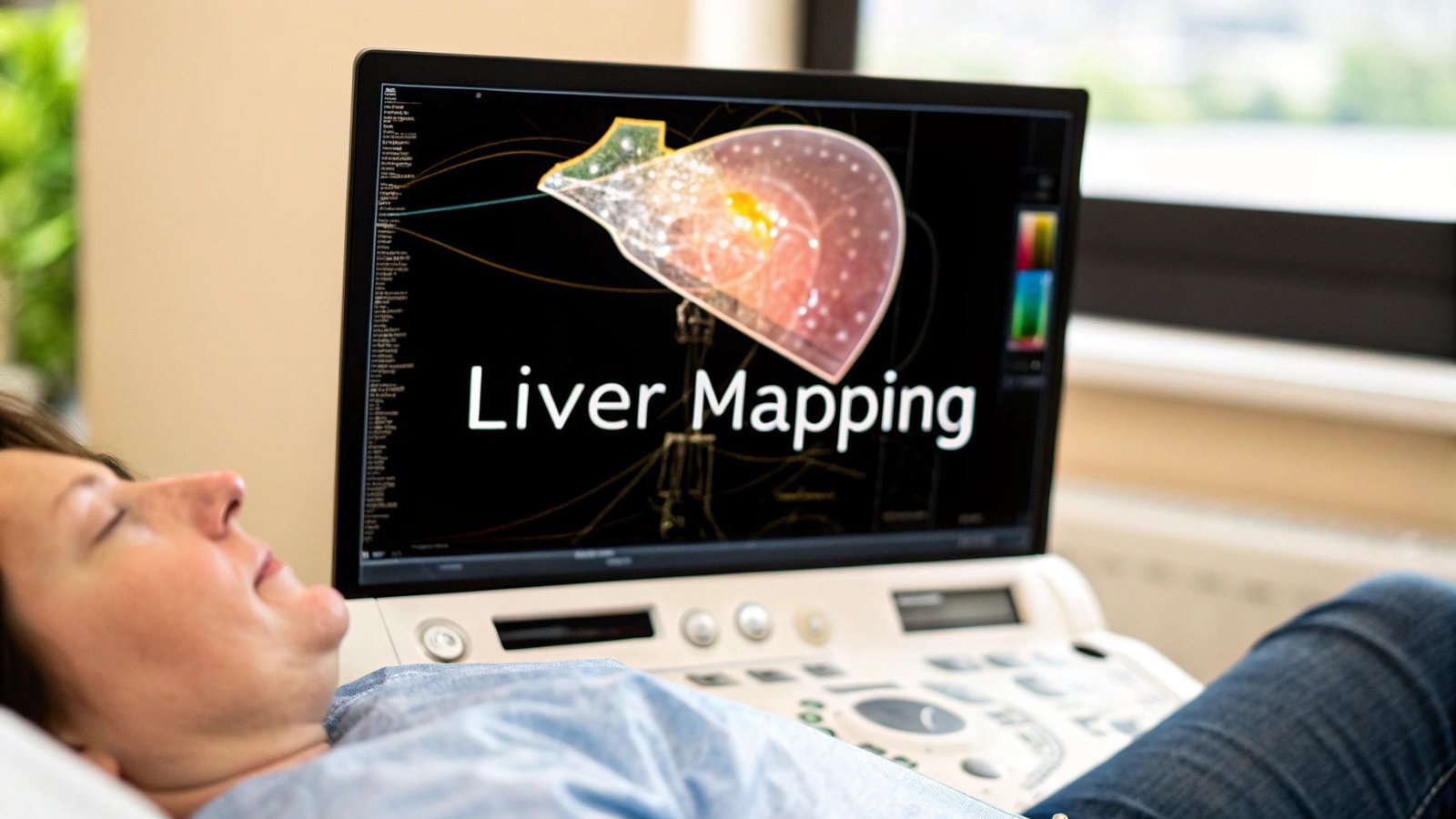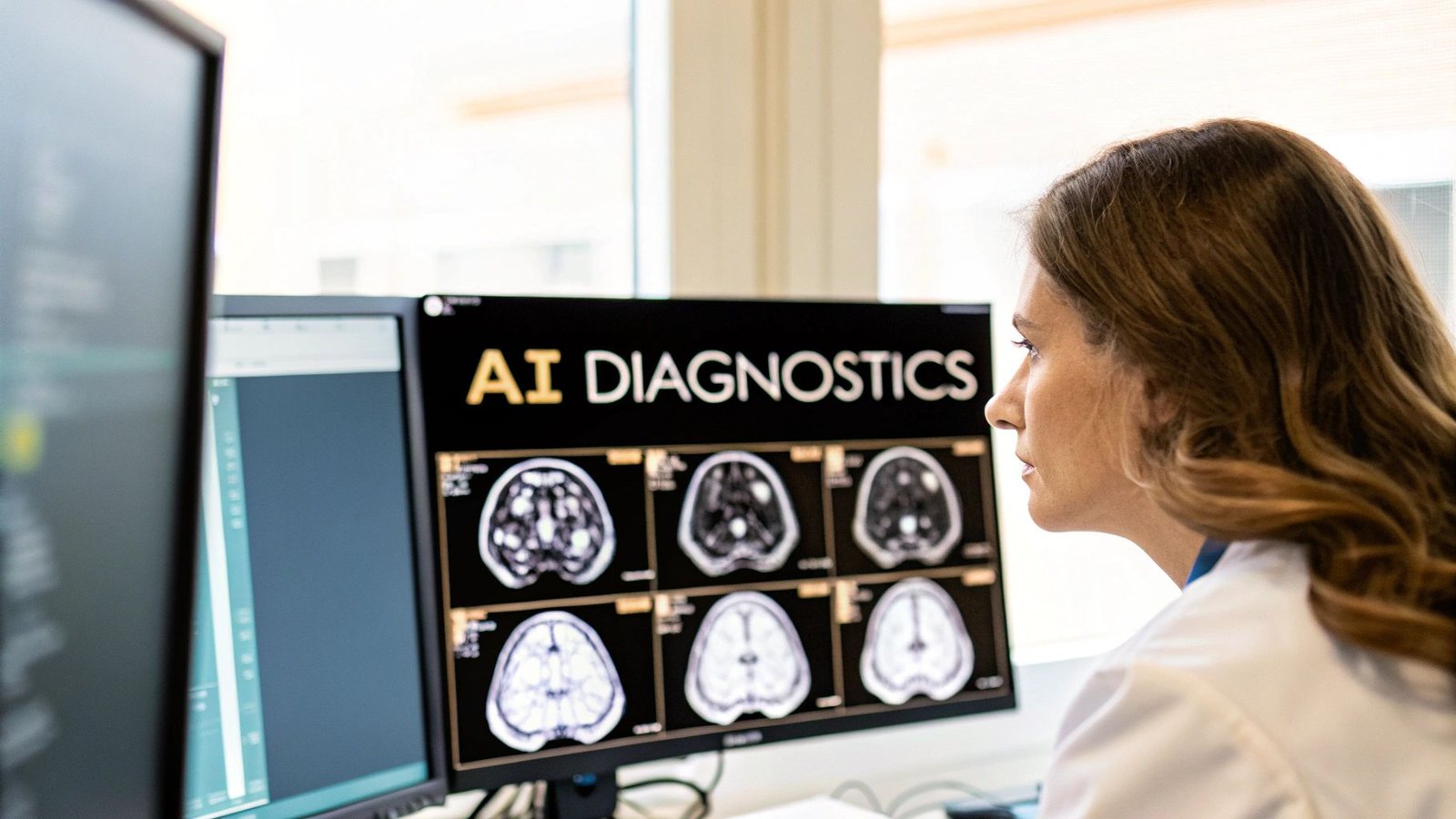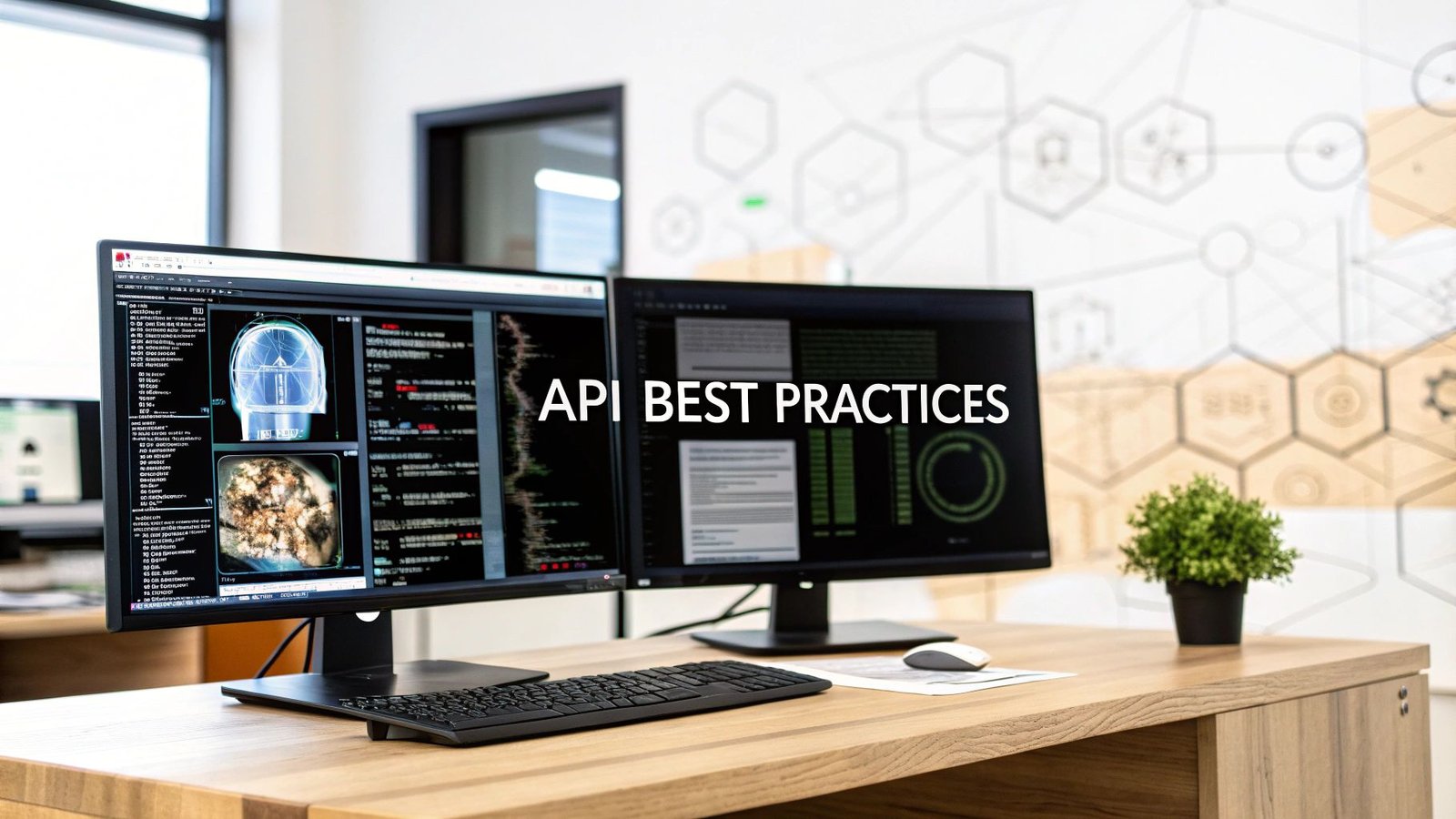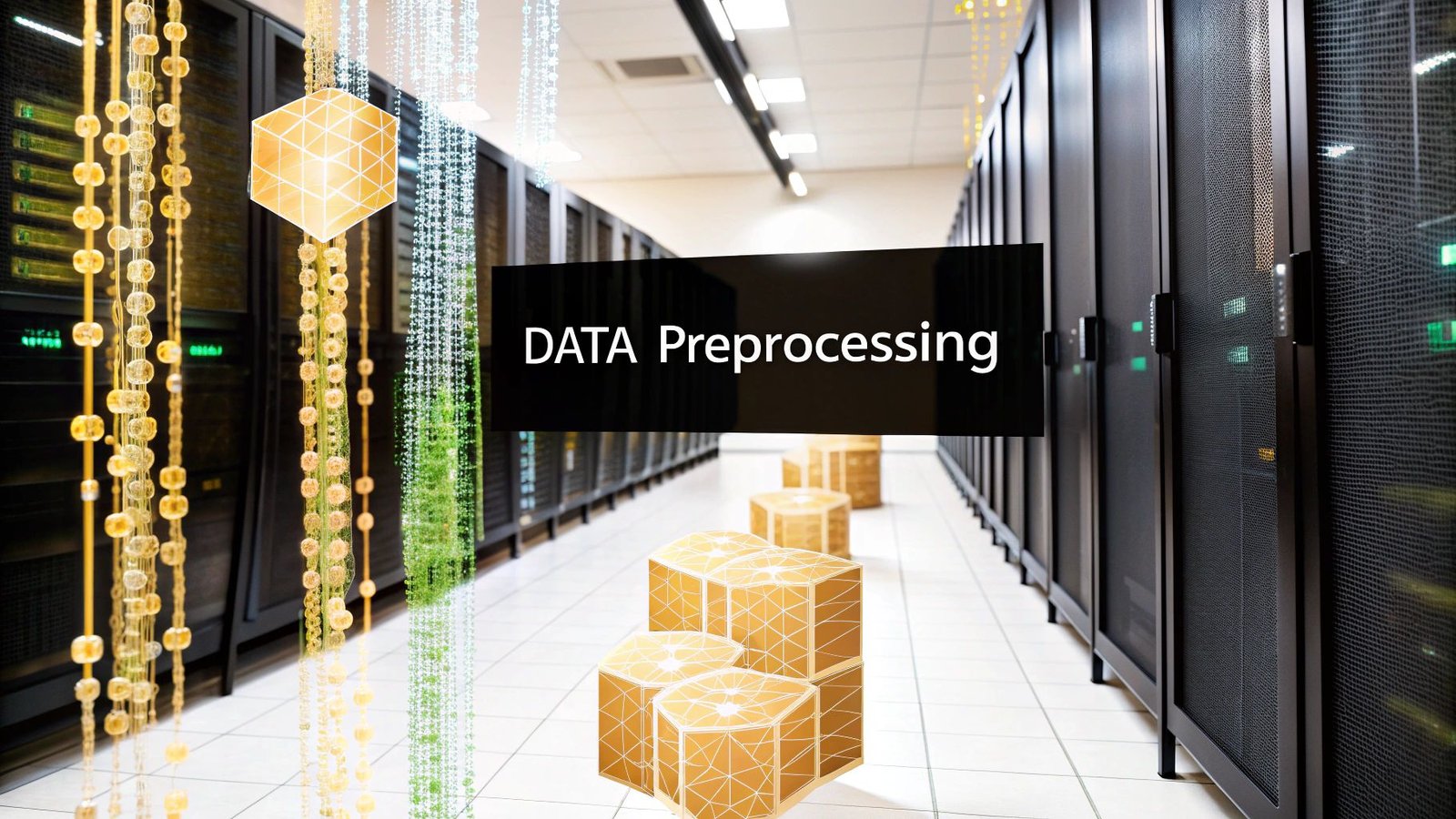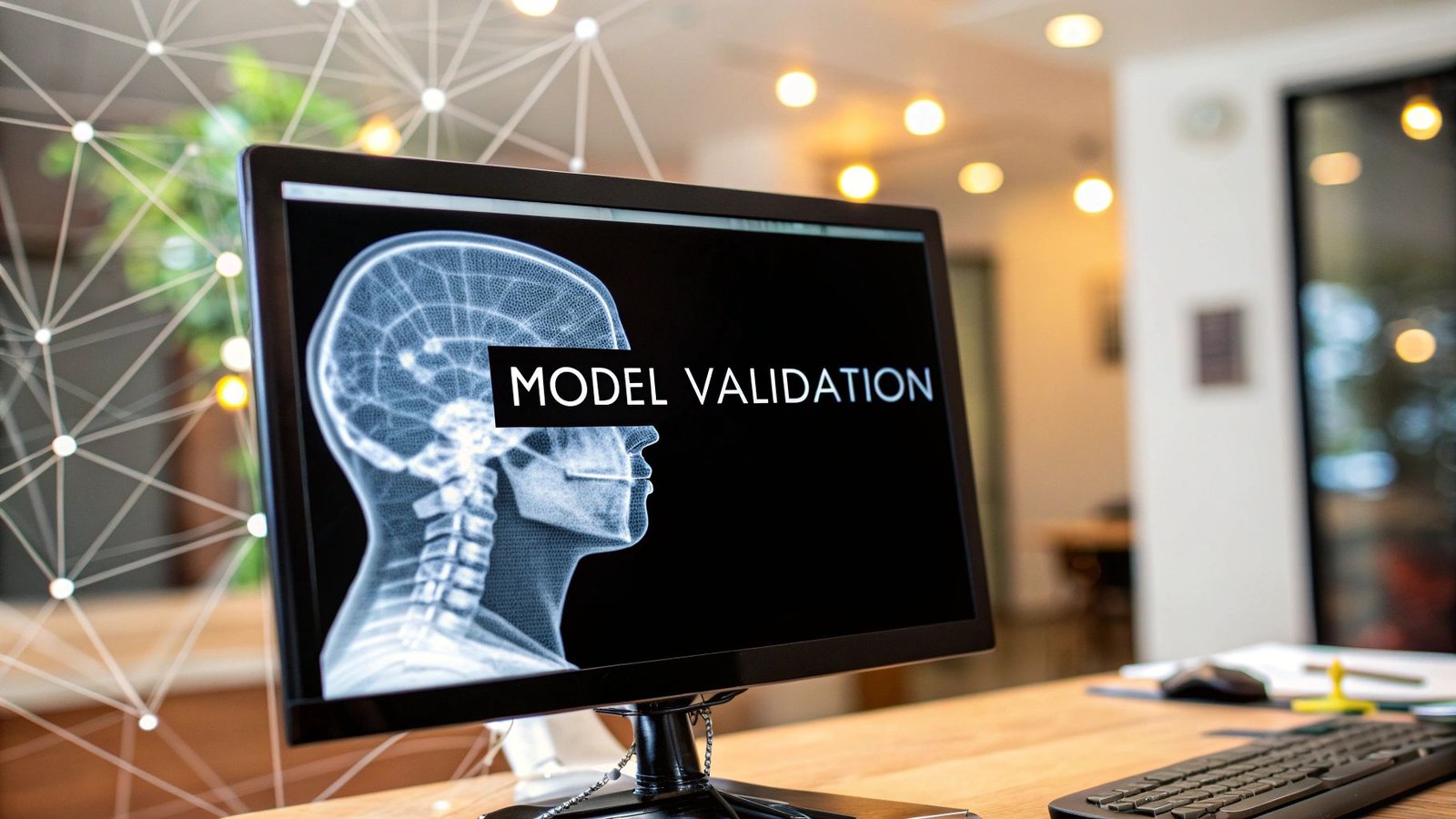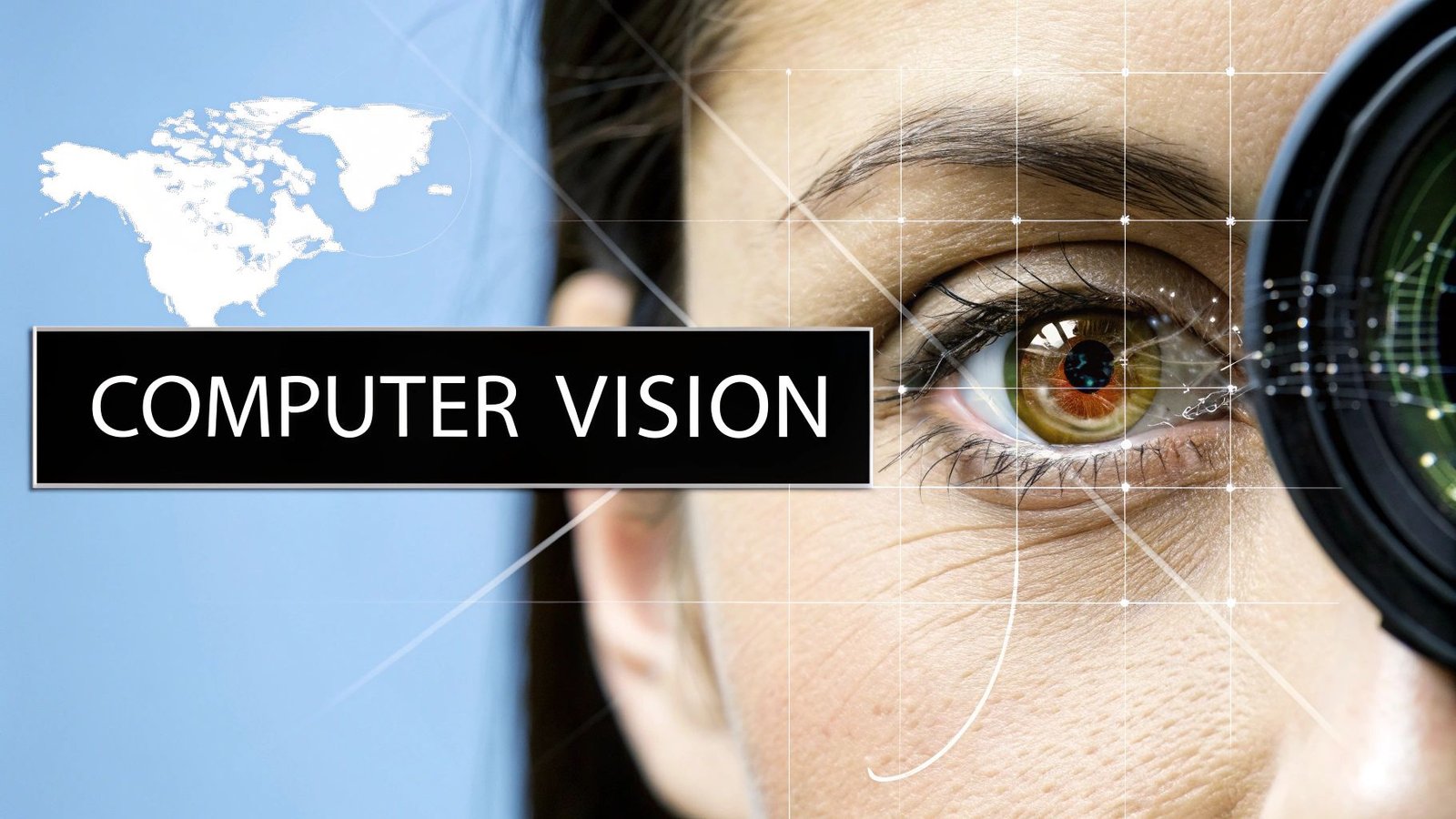When we talk about artificial intelligence in healthcare, we're not talking about replacing doctors with robots. Instead, think of it as giving medical professionals a super-powered assistant. AI is essentially a set of complex computer algorithms designed to sift through massive amounts of medical data, helping clinicians make better-informed decisions. It can process information at a scale and speed that's simply beyond human ability, which is key for spotting diseases earlier, creating personalized treatments, and making hospitals run more smoothly.
Understanding the Core of Medical AI
At its heart, AI in medicine is all about pattern recognition. It’s a lot like how a medical student learns, but on an incredible scale. While a student studies textbooks and sees patients over years, an AI model can analyze millions of patient records, medical images, and clinical trial results in a matter of seconds. This allows it to find subtle connections and correlations that even the most experienced human eye might overlook.
Of course, for these systems to work their magic, they need clean, organized information. This is where behind-the-scenes work like data parsing and management becomes essential. It’s the process of taking messy, complex health data and structuring it so the AI can actually understand and learn from it.
How AI Works in a Clinical Setting
Unlike older software that followed rigid, pre-programmed instructions, modern medical AI uses machine learning (ML) and natural language processing (NLP) to adapt and learn on its own. This flexibility has opened the door to a huge range of applications that are quickly becoming standard practice.
To get a clearer picture of where AI is making the biggest waves, the technologies below are the most important ones to understand. They form the foundation for nearly every AI-driven tool in medicine today.
Core AI Technologies Shaping Modern Medicine
| AI Technology | Primary Role in Healthcare | Real-World Example |
|---|---|---|
| Machine Learning (ML) | Identifying patterns in data to predict outcomes and classify information. | Analyzing patient data to predict the likelihood of a specific disease. |
| Natural Language Processing (NLP) | Understanding and interpreting human language from clinical notes and reports. | Extracting key patient information from unstructured doctors' notes. |
| Deep Learning | A sophisticated type of ML used for complex pattern recognition, especially in images. | Detecting cancerous cells in pathology slides or tumors in MRI scans. |
| Computer Vision | Enabling machines to "see" and interpret medical images like X-rays and CT scans. | Identifying fractures in X-ray images that are difficult to see with the naked eye. |
These technologies aren't just theoretical concepts; they are the engines driving practical tools that are already in use, changing how care is delivered.
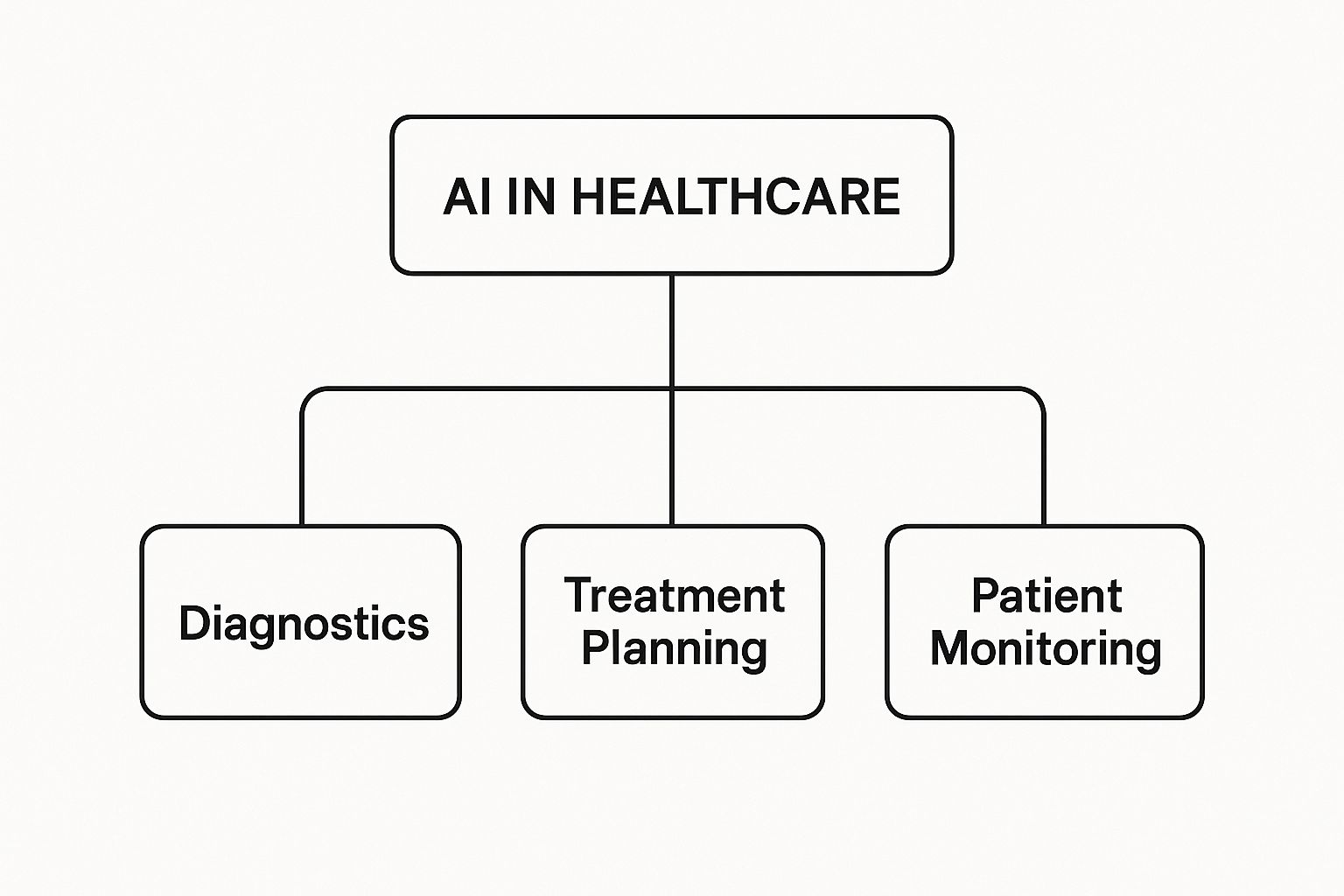
This shift isn't just a trend—it's a full-blown industry transformation. The AI healthcare market, currently valued at around $32.34 billion, is expected to skyrocket to $431.05 billion by 2032. This explosive growth shows just how committed the healthcare world is, with an estimated 80% of hospitals globally already using some form of AI to enhance patient care and streamline their operations.
The True Goal of AI Integration
Ultimately, the aim of bringing AI into healthcare is to enhance, not replace, human expertise. By automating repetitive tasks and delivering deep analytical insights, AI gives doctors, nurses, and researchers their most valuable resource back: time. This allows them to focus on the parts of the job that require a human touch—compassionate patient care, complex problem-solving, and nuanced clinical judgment.
The objective isn't to create autonomous robot doctors but to build collaborative systems that enhance the precision, speed, and effectiveness of medical professionals, leading to better outcomes for everyone.
This partnership between human intelligence and machine efficiency is what’s powering the next generation of medical breakthroughs. It’s a practical toolkit helping us answer tough questions, from finding the earliest signs of Alzheimer's in a brain scan to predicting which cancer therapy will work best for a specific person.
How AI Is Transforming Medical Diagnostics

When we talk about the real-world impact of AI in healthcare, medical diagnostics is where things get truly exciting. Imagine giving a radiologist or a pathologist a second set of eyes—one that has meticulously studied millions of medical images and never gets tired or distracted. That’s essentially what an AI diagnostic tool is, and it's already making disease detection faster and more precise.
It all starts with training. A machine learning model is fed an enormous library of data, not just a few hundred examples, but thousands or even millions of labeled medical images. We’re talking about everything from X-rays and CT scans to MRIs and pathology slides. By sifting through this vast collection, the AI learns to pick up on the incredibly subtle patterns, textures, and anomalies that point to specific diseases.
This deep training enables the AI to spot things the human eye might miss, especially after a long shift. For a radiologist who has to interpret hundreds of scans every day, this kind of support is a genuine game-changer. It helps flag even the smallest suspicious area for a closer look, significantly cutting down on the risk of diagnostic errors.
Enhancing Accuracy in Medical Imaging
Medical imaging is where AI's diagnostic abilities are on full display. Radiologists and pathologists face immense pressure to interpret a staggering volume of complex images quickly and without error. AI steps in not as a replacement, but as a brilliant assistant, pre-analyzing scans to highlight potential areas of concern before the doctor even lays eyes on them.
This human-AI collaboration creates a workflow that is both more efficient and more reliable. Think about it: an AI might catch a tiny lung nodule on a chest X-ray—a potential early sign of cancer—and immediately draw the radiologist's attention to it. This frees up the human expert to focus on the most critical parts of the scan.
Here are just a few specific ways AI is already making a difference in medical imaging:
- Tumor Detection: In oncology, AI models analyze MRI and CT scans to outline tumors with incredible precision, giving doctors a clearer roadmap for planning treatments.
- Fracture Identification: In a busy emergency room, AI can rapidly scan X-rays for hairline fractures that are notoriously difficult to see, helping to speed up triage and get patients the care they need faster.
- Neurological Conditions: New algorithms are learning to spot the earliest signs of diseases like Alzheimer's or multiple sclerosis by tracking subtle changes in brain scans over time.
Real-World Examples of AI in Action
This isn't just theory; these tools are actively being used in clinics and hospitals, and they are saving lives. By helping doctors catch diseases earlier and more accurately, AI gives patients a critical head start in their fight. It shifts the entire paradigm, allowing treatment to begin when it's most likely to work.
AI's power isn't just about speed. It's about finding hidden connections in medical data that lead to earlier detection. Some algorithms can even predict a patient's risk of disease from their health records long before clear symptoms emerge, moving medicine from reaction to prevention.
Take diabetic retinopathy, for instance. It’s a leading cause of blindness, but it's entirely preventable if caught early. An AI algorithm can now analyze a retinal scan in minutes and spot signs of the disease with an accuracy that rivals, and sometimes even surpasses, human ophthalmologists. This makes large-scale screening possible, particularly in remote or underserved communities.
Pathology offers another powerful example. Manually scanning a tissue slide for cancer cells is a painstaking, time-consuming job. Today, AI-powered microscopes can scan the entire slide, pinpointing malignant cells with stunning accuracy. This helps pathologists confirm a diagnosis faster and with more confidence, improving consistency from one lab to another. It’s clear that artificial intelligence in healthcare has moved far beyond being a buzzword—it's becoming an indispensable clinical tool.
Crafting Personalized Treatments with AI
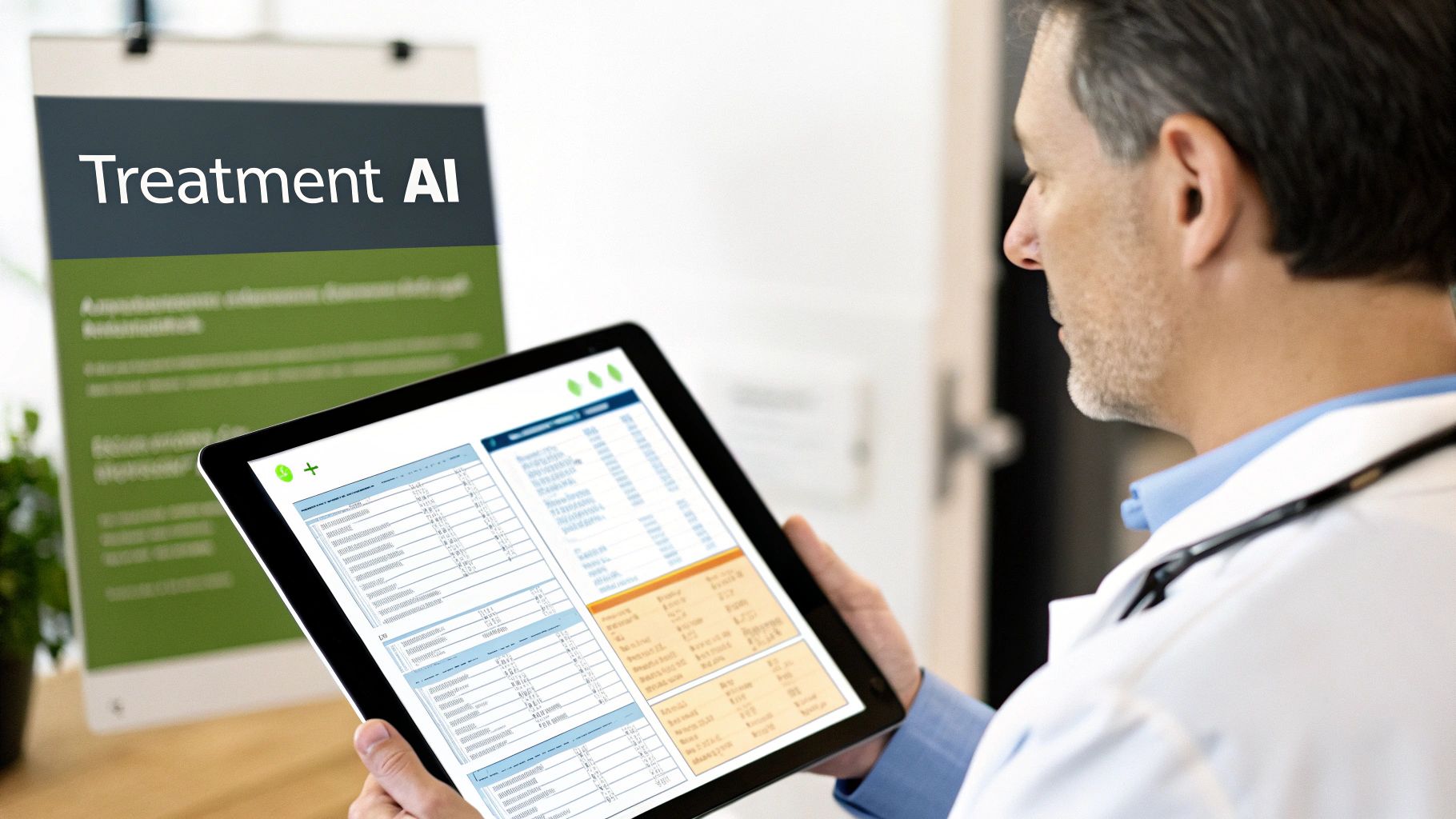
While getting a faster diagnosis is a huge win, the real game-changer for artificial intelligence in healthcare is what happens next: treatment. We're finally starting to move away from the old one-size-fits-all model of medicine. Instead of just treating a disease, AI gives clinicians the tools to treat the individual by tailoring therapies to their unique biology and lifestyle.
Think about it. A treatment plan could be based not just on the name of a disease, but on a deep dive into a patient’s genetic code, their entire medical history, and even environmental factors. This is the heart of precision medicine, and AI is the engine that makes it run. It can dig through mountains of data to predict how a specific person might respond to different therapies, helping doctors pick the most effective option right from the start.
From Broad Strokes to Precise Actions
Traditional medicine often has to rely on treatments designed for the "average" patient. Chemotherapy is a great example—it’s a powerful weapon against cancer, but its effects can be brutal and widespread. AI allows oncologists to be much more targeted. By analyzing a tumor's specific genetic signature, an AI model can help pinpoint which drug is most likely to knock out that particular cancer.
This precision is a win-win. First, it dramatically boosts the odds of a successful outcome by hitting the disease where it's most vulnerable. Second, it saves patients from enduring difficult treatments that might not even work, sparing them unnecessary side effects and emotional strain. It’s a fundamental shift from a strategy of trial-and-error to one that’s guided by data.
We’re already seeing this approach make a difference in several areas:
- Oncology: AI can help find the best drug cocktail for a patient’s tumor by analyzing its unique genomic profile.
- Pharmacogenomics: It can predict how a person's genes will influence their reaction to certain medications, helping to avoid dangerous side effects.
- Chronic Disease Management: AI helps create customized plans for diet, exercise, and medication for patients managing conditions like diabetes or heart disease.
Accelerating the Discovery of New Drugs
Beyond just personalizing existing treatments, AI is massively speeding up the process of discovering new ones. Bringing a new drug to market is a famously long and expensive journey, often taking more than a decade and costing billions. AI is helping to clear many of the hurdles that clog up this pipeline.
For example, one of the very first steps in drug discovery is finding molecules that could potentially block a disease-causing protein. AI can run massive simulations, virtually testing millions of compounds to see how they interact. A process that would take years of painstaking work in a lab can now be done in a tiny fraction of the time.
By simulating how different molecules behave and bind to biological targets, AI can flag the most promising drug candidates with incredible speed and accuracy. This shortens the long road from the research lab to clinical trials, getting life-saving therapies to patients much faster.
This computational method doesn't just find winners; it also weeds out the likely failures early on. This saves an enormous amount of time and money, allowing researchers to pour their resources into compounds that have the best shot at success. Companies like PYCAD are building the essential AI infrastructure that enables these advanced medical imaging and analysis tools.
Tailoring Therapies in Real Time
Finally, AI’s job isn’t done once a treatment plan is in place. It remains a crucial partner throughout a patient's care. AI systems can continuously monitor how a patient is responding to a therapy by analyzing data from lab results, new scans, and even information from wearable devices.
If a treatment isn't working as expected or if a patient develops side effects, the system can flag it for the clinical team immediately. This allows for quick adjustments to the plan, making sure the therapy is always optimized for the patient's current condition. This constant feedback loop is what makes AI-driven personalized medicine so powerful—it’s dynamic, responsive, and always focused on the best possible outcome for every single patient.
Using Predictive Analytics for Preventive Care
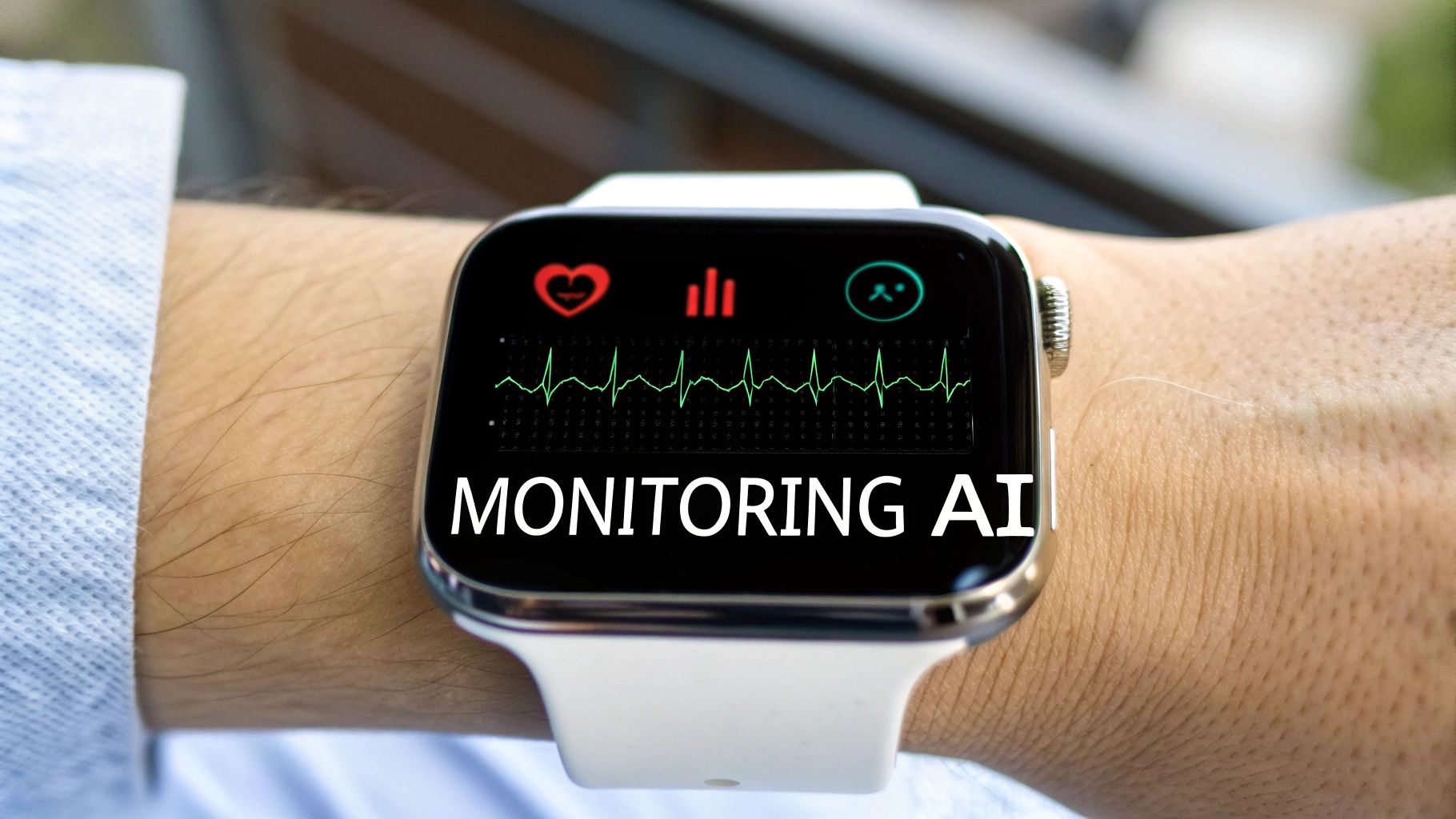
While diagnostics and treatment are critical, one of the most exciting frontiers for AI in healthcare is its power to shift medicine from being reactive to truly proactive. For centuries, healthcare has primarily been about responding to sickness. With predictive analytics, we're giving clinicians something incredible: the ability to peer into the future and identify patients at high risk long before they ever feel sick.
Think of it like having a tireless health detective on the case 24/7. An AI model can sift through mountains of data—electronic health records (EHRs), lab results, real-time data from wearables, and even public health trends. It connects dots that no human could possibly see, flagging a patient who, based on subtle patterns, has a high statistical chance of being readmitted to the hospital or developing a deadly condition like sepsis.
This kind of foresight is a complete game-changer. Instead of waiting for a patient to crash, the care team gets an early warning. This gives them the time to step in with preventive care, craft a personalized plan, and watch the patient more closely. What could have been a full-blown emergency becomes a managed outcome.
Identifying High-Risk Patients Before They Decline
The real magic of predictive analytics is finding those hidden signals in patient data that point to future problems. For example, a model might analyze a patient's vital signs, medication history, and recent lab work to calculate their risk of heart failure over the next six months. If that risk is high, the system can automatically ping the patient's primary care physician.
This opens the door to early, targeted interventions that can make all the difference.
- Preventing Hospital Readmissions: An AI can pinpoint patients who are likely to end up back in the hospital after being discharged. Knowing this, the hospital can arrange for telehealth check-ins, home health visits, or extra support to make sure their recovery stays on track.
- Managing Chronic Diseases: For someone with diabetes, an AI could predict blood sugar spikes by looking at their diet logs and activity data from a wearable. This prompts them to make small, proactive adjustments before a problem occurs.
- Forecasting Disease Outbreaks: On a much larger scale, these models can analyze regional data to predict flu outbreaks. This allows hospitals to get ready for a surge of patients by stocking up on supplies and adjusting staff schedules.
This proactive approach isn't just better for a person's long-term health; it also dramatically eases the burden on the entire healthcare system.
The Economic and Clinical Impact of Prevention
The push toward preventive care isn't just about good medicine—it’s also driven by powerful economic realities. It is almost always cheaper to prevent an illness than to treat one. And we're already seeing incredible returns from these tools. AI-driven models have led to up to a 50% reduction in hospital readmissions and a 30% decrease in unnecessary medical tests.
The market is certainly taking notice. The predictive analytics technology that powers this shift was valued at over $14 billion and is expected to grow at a compound annual rate of about 24% through 2030. This isn't just hype; roughly 65% of U.S. hospitals are already using predictive models inside their EHR systems to flag at-risk patients. You can dig deeper into these numbers by exploring comprehensive AI in healthcare statistics.
By looking ahead, predictive analytics empowers clinicians to stop problems before they start. It moves the focus from managing sickness to preserving wellness, which is the ultimate goal of effective healthcare.
Creating a Data-Driven Safety Net
At the end of the day, predictive analytics works like a highly sophisticated safety net. It's constantly scanning for risk, allowing healthcare providers to put their resources exactly where they're needed most. For a patient with a complicated medical history, this could mean a personalized discharge plan designed specifically to keep them out of the ER.
For an entire hospital, it might mean identifying a rising sepsis risk on a specific floor and rolling out new protocols to stop it in its tracks. This ability to anticipate needs and act first is one of the most profound ways artificial intelligence is making patients safer and fundamentally improving how we deliver care.
Making the Hospital Run Smoother with AI
A hospital is so much more than just the treatment rooms and diagnostic labs you see. Behind the scenes, it's a massive, complex operation. How well those behind-the-scenes tasks are managed has a direct impact on patient care, staff burnout, and the bottom line. This is another area where artificial intelligence in healthcare is quietly making a huge difference, automating the administrative and logistical work that can easily overwhelm medical professionals.
Think about the mountain of paperwork, the tangled web of scheduling, and the constant supply chain puzzles that hospitals juggle every single day. AI offers a way to bring order to this chaos. By taking over the repetitive, data-intensive jobs, it frees up nurses, doctors, and administrators to focus on what truly matters—the work that demands human insight, skill, and compassion. This creates a more efficient and less stressful environment for everyone.
Cutting Through the Administrative Red Tape
One of the most powerful applications of AI in a hospital is its ability to fight administrative burnout. It’s no secret that clinicians spend a huge chunk of their day on documentation and other clerical tasks. AI-powered tools are stepping in to slash that burden.
For instance, Natural Language Processing (NLP)—the same tech that lets your phone understand what you say—can now listen to a doctor's conversation with a patient. As they talk, the AI transcribes their discussion and intelligently fills out the electronic health record (EHR) on the fly. This one application can save a doctor hours of typing each day, which not only fights burnout but also leads to more accurate patient records.
AI is also tackling the notoriously complex world of medical billing and coding. Instead of relying on manual, error-prone processes, these systems can analyze patient charts and treatments to generate accurate codes. This means fewer denied claims and a healthier financial outlook for the hospital.
Improving the Flow of People and Supplies
Running a hospital efficiently is like conducting a massive orchestra; it’s about getting the right people and resources to the right place at the right time. AI is proving essential for fine-tuning these daily operations, from managing beds to anticipating patient needs, as seen in many solutions for healthcare providers.
Here are a few ways AI is helping on the ground:
- Smart Scheduling: AI algorithms can juggle patient appointments, operating room bookings, and staff schedules with remarkable precision. By analyzing past data, they can predict no-show rates and build smarter schedules that cut down on patient wait times and make the most of every resource.
- Supply Chain Management: A hospital can't afford to run out of critical supplies. AI systems can forecast demand for everything from medications and PPE to surgical tools, automating orders to prevent shortages while also cutting down on waste.
- Bed Management: Getting a patient a bed quickly is a constant challenge. AI can predict when current patients are likely to be discharged, helping staff turn over beds faster and shorten wait times for people coming in from the ER.
By solving these logistical puzzles, AI does more than just save money. It directly creates a better experience for patients and helps relieve clinician burnout—a serious issue that threatens the quality and safety of care everywhere.
When AI takes on the operational heavy lifting, it allows a hospital to run like a well-oiled machine. This ensures the human experts at its core can put their time and energy where it truly belongs: caring for patients.
Navigating the Ethical Challenges of Medical AI
While it’s easy to get excited about the benefits of AI in medicine, we can't get a complete picture without an honest look at the very real challenges. To actually realize AI's potential, we have to navigate some serious ethical and practical hurdles. These aren't just details to iron out later; they're core issues that will make or break the trust of both patients and the clinicians who care for them.
The most immediate concern that comes to mind is patient data privacy. AI models are incredibly data-hungry—they need massive amounts of information to learn and become accurate. This immediately creates a tension with strict privacy laws like HIPAA, which exist to protect our most sensitive health information. Making sure this data is completely anonymized and handled securely is a non-negotiable first step.
Then there's the major risk of algorithmic bias. An AI system is only as good as the data it learns from. If that data reflects existing health disparities—say, it’s mostly collected from one demographic group—the AI can absorb and even amplify those biases. This could create a future where AI tools are less accurate for certain populations, making health inequities worse, not better.
The Problem of the Black Box
One of the most widely discussed issues in medical AI is what’s known as the "black box" problem. This is especially true for deep learning models that can give a stunningly accurate answer—like spotting a tumor on a scan—but can't explain how it arrived at that conclusion. The reasoning is lost inside a complex, opaque web of algorithms.
This lack of transparency is a huge problem in medicine, a field where understanding the "why" behind any decision is absolutely critical. For a doctor to confidently act on an AI's suggestion, they need to understand its logic. Solving this is essential for building clinical trust and making sure AI is used as a responsible partner in care.
The core ethical dilemma is this: How can we fully trust a medical recommendation if the system making it cannot explain its logic? This question sits at the heart of the push for more transparent and "explainable AI" in healthcare.
The Need for Oversight and Expertise
Finally, the rapid expansion of AI in medicine is shining a spotlight on the need for clear regulatory oversight and a deeper pool of specialized talent. AI's growth is being fed by an explosion of medical data, which is on track to exceed 10 trillion gigabytes. This data has created massive opportunities, with 94% of healthcare organizations already using AI in some form.
But there's a catch. A shortage of people who are experts in both AI and medicine can slow things down and drive up costs. Even with these hurdles, the AI healthcare market is expected to grow at an incredible 38.5% CAGR through 2033. You can explore detailed AI healthcare market statistics to see just how fast this space is moving.
As these powerful tools become more woven into daily clinical practice, they force us to ask some tough questions:
- Who is responsible if an AI makes a mistake? Is it the software developer, the hospital that bought it, or the doctor who used it?
- What standards must an AI meet before it can be used with patients? We need clear benchmarks to ensure these tools are safe and effective.
- How do we ensure AI is used fairly for everyone? We have to actively prevent a "digital divide" where only certain people get access to the best AI-driven care.
Ultimately, solving these challenges isn't a job for any one group. It requires developers, regulators, ethicists, and clinicians to all work together. The goal is to build a framework that puts fairness, transparency, and patient well-being first. Only by tackling these issues head-on can we responsibly unlock everything that what artificial intelligence in healthcare can truly become.
Of course. Here is the rewritten section, designed to sound natural, human, and authoritative.
Common Questions About AI in Healthcare
Anytime a powerful new technology enters a field as personal as medicine, it’s natural to have questions. There's a lot of noise out there, so let's cut through it and address some of the most common things people wonder about when they hear "AI in healthcare."
Will AI Replace My Doctor?
This is probably the number one question on everyone’s mind. The short answer? No.
Think of it this way: AI is becoming an incredibly sophisticated tool, not a replacement for human expertise. It’s more like a super-powered assistant that can sift through massive amounts of data—like thousands of medical images or patient records—in seconds. This frees up doctors to do what they do best: apply critical thinking, connect with patients, and make nuanced care decisions. The final call will always rest with a human clinician.
How Do I Know If AI Is Being Used in My Care?
That’s a great question, and one the medical community is actively discussing. Right now, there isn't always a strict requirement for a hospital to tell you if an AI algorithm helped analyze your X-ray or flagged a potential issue in your lab results.
However, the tide is turning toward greater transparency. Patients deserve to know, and both ethical guidelines and new regulations are being developed to make sure you're kept in the loop.
The most likely future is one where AI works quietly and effectively in the background, much like the software that manages your electronic health records today. The real measure of success isn't the technology itself, but the quality of care you receive—which AI is there to enhance.
Ultimately, your right to be informed is crucial for building trust. Don't ever hesitate to ask your doctor or care team about the tools and technologies they're using to develop your treatment plan.
Is AI Safe and Reliable Enough for Medical Decisions?
Safety is non-negotiable, and it’s the single most important factor. Before any AI tool sees the light of day in a clinic, it goes through an incredibly rigorous validation process. In the United States, many of these tools must get clearance from regulatory bodies like the FDA.
These AI systems are trained and tested on huge, diverse sets of data to prove they are not only accurate but also equitable, performing reliably for people of all backgrounds. But no technology is flawless, which is why several safeguards are always in place:
- Continuous Monitoring: Deployed AI models are watched constantly to ensure their performance doesn't drift or degrade over time.
- The Human in the Loop: A qualified medical professional is always the one to make the final diagnosis or treatment decision.
- Strict Data Security: Patient privacy is paramount. All systems must comply with strict regulations like HIPAA to protect your sensitive health information.
So, when we talk about what is artificial intelligence in healthcare, we're really talking about a powerful but carefully controlled tool. Its reliability isn't just about the algorithm; it's about the entire system of testing, oversight, and the essential expertise of the healthcare professionals who use it.
At PYCAD, we're the ones building the backbone for these advanced medical tools. We specialize in the entire lifecycle of AI for medical imaging—from handling and anonymizing data to training and deploying models. We partner with innovators to help bring safe, effective AI solutions to the clinicians and patients who need them. Learn more about our AI development and MLOps services.

